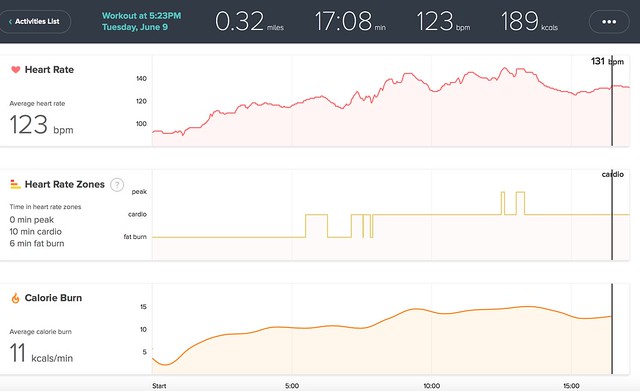This may be a bit late to one of the party but @elemming and I have got ourselves Fitbit Flex HR wearables. This little devices track all sorts of walking movement, sleep patterns and most importantly heart rate. The idea is you wear them all the time and aim to do 10,000 steps a day. I was more interested in the heart rate monitor though and what it meant to my Choi Kwang Do training. Whilst this may stray into exercise bore territory I though it worth showing our martial art in internet of things (IOT) terms with some nice graphs.
It is easy when devices and numbers are in place to over fixate on the numbers, but it makes sense to use instrumentation as a check and balance for your own personal experience.
The last few weeks I have ramped up my training at home, having practiced this art for 3 1/2 years I am still very much learning, but I do have a body of experience to draw upon and some degree of consistent feeling to how particular techniques are going to how much extra I can put into a pattern or speed drill. I have used heart rate monitors before. I used a chest strap one about 18 years ago when I had a little burst of getting fit. (That’s part of the article in may portfolio piece virtual athletes – Sports Technology and games). It was where I came to understand it the different heart rate zones based on age.
I had considered other sports wearables, the Apple Watch was a little to expensive, and other people we knew had fitbits so it added to the game side of things with leaderboard and comparing data.
Yesterday was the first half of a day with it, I had already done 1 hour of Choi in the morning so missed that session. Just before our full class at Basingstoke I did a 17 minute warmup and PACE drill at home.
This involved around 5-6 minutes of stretch. Then 2 minutes of moderate pace punching and kicking on BOB, 2 minutes rest, 1 minute faster harder pace kicking only, 1 minute rest and then 30 seconds flat out with everything. I then warmed down a little with my current combination.
 ” alt=”” />
” alt=”” />
The trace of the heart rate certainly fits the level of work and where I felt I was with my heart rate. PACE drills (Progressive Accelerated Cardio Exertion) is a high intensity short burst training method gradually extending and layering your range. We train for speed and power in short bursts as part CKD rather than long repetitive exercise.
The class session ended up as a very intense one too. We have a number of soon to be black belt students in their run up to a grading. So for the lesson I joined them to do our entire set of patterns. This is around 8-10 minutes of going through each coloured belt curriculum pattern. The pattern is a defined set of movements that build techniques up and up. We can all do this at a good steady pace to maintain the form and technique. After that we had a specific blackbelt recap and evaluation of our current belt. That involved current hand techniques, current kicks, combination and pattern. This then ended with a very high intensity PACE version of the speed drills. This are what they say, fast defined sets of moves. We each had a slightly different set but performed them at the same time. We did inaccessibly fast and multiple sets with a final full on blast at the end of one set flat out (when already feeling flat out). The class then went on with both shield drills and focus mits.

As you can see the initial ramp up is the start of the patterns with almost no heart rate increase, then as it progresses the heart rate starts to climb. The trough after 15 minutes is the rest period before the black belt sets. The plateau at 125 from just before 45 minutes is when the speed is and power are still the same but the body seems to accept this is going to happen. This is when techniques flow the best. It is also when the effort is in holding the equipment for others and encouraging them. It shows the benefit of an intense PACE session soothing into learning mode and technique efficiency.
My resting heart rate is showing at 64bpm after the exercise and sleep which is not too bad.
By contrast, and in not was worse is the walk to school and back

It shows how a nice steady activity, not over doing gets the heart rate in a comfortable fat but position.
So armed with this information, and now with a reference point I can use the device to reflect on various elements of training and hopefully make my techniques better and more effective.
With some improvements in the sensors that detect out body movement we should be abel to make some great strides in how specific body movements are delivered with great effectiveness but being mindful of the more pure nature of a martial art in just doing it and being in the moment.
Pil Seung!

Leave a Reply